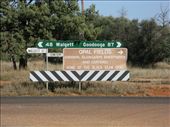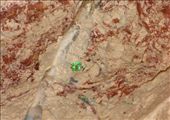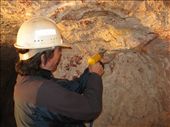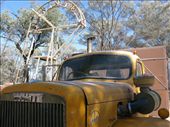“When I close my eyes, I see opals,” said Kelly, shaking his head.
It seems he has a touch of opal fever.
 Lightning Ridge and the surrounding areas are famous for its abundance of opals, and in particular the black opal, which can basically only be found here. For decades, people have visited, and never left. They were entranced by this fiery precious gem; one that constantly changes and flickers in the light.
Lightning Ridge and the surrounding areas are famous for its abundance of opals, and in particular the black opal, which can basically only be found here. For decades, people have visited, and never left. They were entranced by this fiery precious gem; one that constantly changes and flickers in the light.
While I appreciate the area and the gem (and in fact acquired a few for my own personal enjoyment whilst here), I didn’t quite understand the fever itself, until I saw Kelly come down with it.
Lucky, this is one fever that didn’t require a hospital, as it did in Hawaii and Thailand.
There are a few ways you can mine for opal:
- Own a claim. A few thousand dollars, a few safety and environmental courses, and some heavy machinery later, and you have yourself a mineral claim, and the ability to go underground for opal. More on the opal mining process in a minute.
- Go fossicking or “noodling”. You accomplish this silly sounding task by going to the rubbish dumps, where miners have dumped truck after truck load of sandstone from their
 mines. Although miners have a pretty keen eye for opal, it is very easy to miss a chunk while chipping away at the sandstone underground. This is where the fossickers and noodlers can make a living if they work hard enough. A full-time fossicker in a heavily mined area about 60kms from Lightning Ridge can make an average income of $20,000. Some may say that’s pretty meager, while they will say that they’re outside, with nary a care in the world, and enjoying every day. Fossicking is also the most common way for a short-term visitor or tourist to try to get their hands on some opal.
mines. Although miners have a pretty keen eye for opal, it is very easy to miss a chunk while chipping away at the sandstone underground. This is where the fossickers and noodlers can make a living if they work hard enough. A full-time fossicker in a heavily mined area about 60kms from Lightning Ridge can make an average income of $20,000. Some may say that’s pretty meager, while they will say that they’re outside, with nary a care in the world, and enjoying every day. Fossicking is also the most common way for a short-term visitor or tourist to try to get their hands on some opal. - Actually, the most COMMON way for the average tourist to mine for opal, is in the jewelry stores. In Lightning Ridge, you can mine through store after store and dealer after dealer looking for that perfect piece of opal to take home with you.
There are also a number of different types of opals, and ways of fashioning them into gems too. The two main types of opal are:
- Black Opal. Since the back of the stone is black (or almost black, for the “semi-black” or “grey” opals), the colours of the opal shine magnificently. This is the rarest kind of opal, and the Lightning Ridge area is one of the few places in the world to find it.
- White Opal. This is a more common form of opal, with an array of glittering colours shining through a milky white stone. White opals can also be found at Lightning Ridge, as well as the well known mining town of Coober Pedy and other places.
As for finding the opal that will suit your pocketbook and still be “the real deal”, here are a few pointers on the different types you’ll find:
- Solid Opal. Being the most precious type of opal, your wallet will feel the effects of buying a solid stone the most. It is just as it sounds: solid.
- Doublet. A doublet is a thin slice of solid opal, glued on to a black backing of potch (which is technically opal, but is colourless and therefore worthless). Doublets can be quite magnificent since the colours of the stone shine against the dark backing.
- Triplet. This is the lowest grade of opal, but also the least expensive. Similar to a doublet, a triplet is a thin sliver of opal glued onto a dark backing, and then covered on top with a layer of silicone or crystal. This protects the stone, makes it look bigger than it is, and helps the colours of your tiny slice of gem to shine radiantly.
 And of course, ask anybody in town what they prefer, and they wouldn’t be seen with anything other than a solid opal. Then again, they find the bloody things laying on the ground half the time around here.
And of course, ask anybody in town what they prefer, and they wouldn’t be seen with anything other than a solid opal. Then again, they find the bloody things laying on the ground half the time around here.
They say that you know it when you find the perfect piece of opal for you. No two gems are the same, and each has its own shape, colour, and reflective characteristics. On our first full day in town, we finished an afternoon of looking in the jewelry stores and finding nothing but a feeling of being overwhelmed. But we discovered the following day returning to the jewelers, that we somehow missed the opals that were to become ours; it was an instantaneous harmony between beauty and pocketbook.
But opal fever – the real opal fever – takes you beyond the jewelry stores. There is a certain thrill of discovering opal on your own and in its raw form.
“Keep your eyes down when walking around here,” said a fellow we were chatting with one day. “You never know what you’ll find.”
The fact that you can literally find opal on the ground while walking around town is amazing. Talk to anybody who has lived here for a while and they’ve probably found at least a small chunk at some time. This instant possibility of finding a precious gem laying on the ground is one of the contributing factors to getting opal fever.
And when you find one…something catches the corner of your eye, in a white sandy fossick pile. You pick it up, wet it down to clear off the sand, and see a colourful streak of colour in your rock…the feeling of being lucky, rich, and the immediate possibility of more being just around the corner….all are symptoms of opal fever. All you have to do next is sell the farm and move to Lightning Ridge to “strike it rich” mining opal and the deal is done.
But as much as we love “The Ridge”, we aren’t moving there. (Yet). That being said, Kelly still got a chance to stoke the opal fever by “going underground” and visiting the mine of a friend of ours.
We met George and his wife Rosemary while making dinner one night at Warrumbungle National Park. They knew we were headed towards Lightning Ridge, and invited us out to the Grawin just out of town where a lot of the active opal mining is currently happening. We were promised that we’d see the “real deal” out there. 
After parking the van at the Club In The Scrub – a scruffy looking pub that’s also the town library, general store, restaurant, and community centre – we hopped in George’s truck and drove along the dizzying maze of gravel roads to his mining claim.
 After donning hard hats and checking our vertigo and claustrophobia at the door, we were climbing down a ladder 12 metres underground into George’s mine. I was immediately surprised at how spacious the mine was once we were underground; the ceiling was about eight feet high, and the various tunnels and passages connected with other miner’s claims and stretched for kilometers in some places.
After donning hard hats and checking our vertigo and claustrophobia at the door, we were climbing down a ladder 12 metres underground into George’s mine. I was immediately surprised at how spacious the mine was once we were underground; the ceiling was about eight feet high, and the various tunnels and passages connected with other miner’s claims and stretched for kilometers in some places.
We were taught the basics of how to find opal; looking for fault lines, steel bands, and blowdown.  Kelly even got a chance to play with power tools and mine a few seams of opal himself. Although this did nothing to cure his opal fever, we were elated to be in somebody’s mine, mining for opal, and seeing something that the average bear doesn’t get to see.
Kelly even got a chance to play with power tools and mine a few seams of opal himself. Although this did nothing to cure his opal fever, we were elated to be in somebody’s mine, mining for opal, and seeing something that the average bear doesn’t get to see.
George really gave us the royal tour, taking us through the three mining communities that make up the area, and showing us the good places to go fossicking. He then left us to our own devices, and we wiled away the rest of the day fossicking, and telling tall tales with the locals at the busy pub that Friday night.
 The following morning, if we had a spare minute, I always knew were I’d find Kelly: admiring his newly acquired collection of opals in a puddle of sunshine. None of them were particularly valuable, but they were absolutely beautiful chunks of rock with rich blue and black bases, accented by the occasional fleck of precious fire.
The following morning, if we had a spare minute, I always knew were I’d find Kelly: admiring his newly acquired collection of opals in a puddle of sunshine. None of them were particularly valuable, but they were absolutely beautiful chunks of rock with rich blue and black bases, accented by the occasional fleck of precious fire.
Although neither of us was really ready to leave the area, we knew we had to, in order to make the long trip to Broken Hill and the Australian Outback for the next stage of our World Nomads adventure. Opal fever still plagues us, and I still catch Kelly looking for some of the precious gems on the ground even after having left the area entirely. I guess once you have Opal Fever, you have it for good.